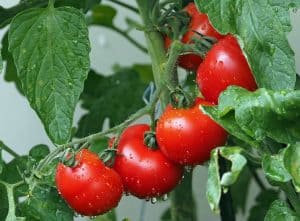When do you plant tomatoes in NC?
When to plant tomatoes in North Carolina – If you’re growing your tomatoes from seed in North Carolina, start your seeds indoors anytime from February 14 through February 28.
If you prefer to purchase transplant tomatoes from your garden center or nursery the best time to purchase and plant them in the garden in NC is April 18 through May 9.
The following table shows final frost dates in spring in NC and first frost dates in fall in NC. Bear in mind there can be a reasonable variation on the dates given.
Obviously, since tomato plants are not tolerant of frost, whatever you do, avoid planting tomato transplants out until well after NC frosts have passed by.
Frost Dates in North Carolina
Tap the chart to enlarge
What Tomato Varieties do Well in NC?
If you grow larger-sized tomatoes you should know that they prefer an ambient air temperature at night of 55° – 65° F so that the fruit sets.
Cherry and grape tomato varieties don’t mind a bit more heat than larger tomatoes. Cherry and grape tomatoes don’t mind higher humidity levels than their larger-sized counterparts. This means you can plant cherry and grape varieties a little later in the season than tomatoes such as beefsteak tomatoes like Beefmaster or Aunt Ruby’s German Green.
One of the keys to successful tomatoes – to a bountiful supply of tomatoes on each plant – is to select appropriate tomato varieties for the NC climate.
There are time-tested tomato varieties that always do well in North Carolina: Better Boy, Whopper, Mountain Pride, Celebrity. These all do well in high heat and high humidity.
Marmara does well, too, with its intense red coloring and lovely sweet flavor. Floralina hybrid tomato is likewise a good one to choose for NC. Floralina tomato was part of a cooperative breeding program care of NC State and University of Florida.
If you have a smaller-sized garden, or indeed, no garden at all – perhaps you have a balcony – cherry and/ or grape tomato varieties are a good way to go.
There’s the dwarf cherry variety Red Robin that thrives in small-sized pots.
Sara’s Galapagos is beautifully sweet.
Lemon Cherry tomato is also very sweet and, as the name suggests, it has a pale-yellow skin. Ideal for salads or snacking.
Some Tomato Varieties Available from the Breeding Program by the NC State University Mountain Horticultural Crops Research and Extension Center
The NC State University Mountain Horticultural Crops Research and Extension Center in Mills River have developed numerous tomato cultivars that have disease resistance to Fusarium wilt race 3, late blight, and tomato spotted wilt virus. The breeding program is also breeding for a variety of benefits (at least to those of us that grow tomatoes) including larger fruit sizes, optimal smoothness, firmness, earliness, crack resistance, color, high-temperature fruit set, shelf life, and, of course, flavor.
Among the program’s available varieties are ‘Mountain Magic’, ‘Mountain Glory’, ‘Mountain Pride’, and ‘Mountain Majesty’. All of these varieties are very good for slicing.
Then, for disease resistance, there are a couple of cherry types including ‘Mountain Belle’ and ‘Sun Gold’, and there is also a plum type named ‘Plum Crimson’ and a grape type named ‘Mountain Honey’.

How to Plant Tomatoes in NC
The rules for NC apply to anywhere else in terms of planting tomatoes.
If your soil is very sandy or clay-like add plenty of organic matter. Two to three inches of organic matter can be incorporated into the top six to nine inches of soil.
Space your tomato plants around 24 inches apart within rows. If you’re going to plant more than one row then leave around three or four feet between rows.
Tomato plants, while they do not like to sit in water, they do like a copious supply of water, particularly when the weather is hot. Soak your tomatoes deeply once every seven days. If the weather is particularly hot and dry, water your tomatoes more often to compensate.
Start out with a starter tomato fertilizer. This will likely be high in nitrogen (N). That’s ideal since nitrogen is necessary for the growth of foliage – leaves, and stems. It will, or should be, high in phosphorus (P). Phosphorus is required for healthy root growth.
At a later time in the growing season, once the tomato plants are somewhat developed but well before they start to fruit, it’s time to alter the fertilizer. You’ll want a fertilizer that is high in potassium (K) at this stage. Potassium is critical for the growth of fruit.
